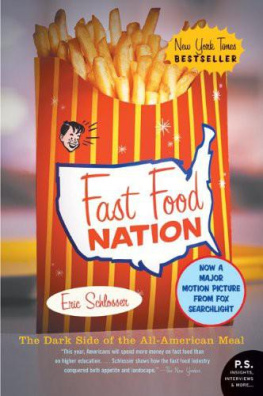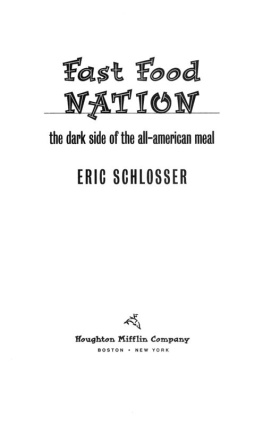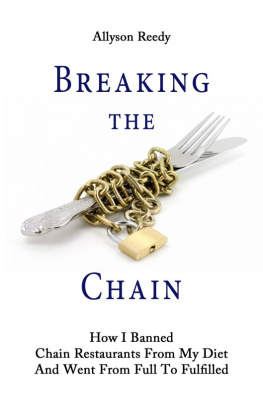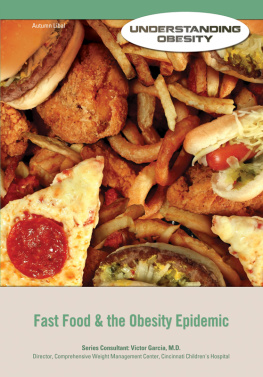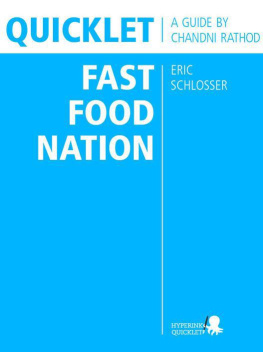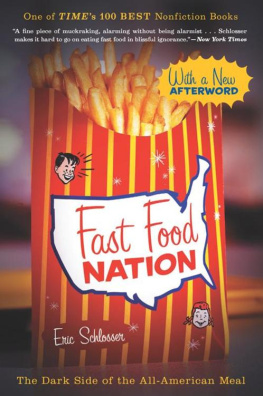Eric Schlosser - Fast Food Nation: The Dark Side of the All-American Meal
Here you can read online Eric Schlosser - Fast Food Nation: The Dark Side of the All-American Meal full text of the book (entire story) in english for free. Download pdf and epub, get meaning, cover and reviews about this ebook. year: 2005, publisher: Harper Perennial, genre: Children. Description of the work, (preface) as well as reviews are available. Best literature library LitArk.com created for fans of good reading and offers a wide selection of genres:
Romance novel
Science fiction
Adventure
Detective
Science
History
Home and family
Prose
Art
Politics
Computer
Non-fiction
Religion
Business
Children
Humor
Choose a favorite category and find really read worthwhile books. Enjoy immersion in the world of imagination, feel the emotions of the characters or learn something new for yourself, make an fascinating discovery.
- Book:Fast Food Nation: The Dark Side of the All-American Meal
- Author:
- Publisher:Harper Perennial
- Genre:
- Year:2005
- Rating:4 / 5
- Favourites:Add to favourites
- Your mark:
- 80
- 1
- 2
- 3
- 4
- 5
Fast Food Nation: The Dark Side of the All-American Meal: summary, description and annotation
We offer to read an annotation, description, summary or preface (depends on what the author of the book "Fast Food Nation: The Dark Side of the All-American Meal" wrote himself). If you haven't found the necessary information about the book — write in the comments, we will try to find it.
Fast Food Nation: The Dark Side of the All-American Meal — read online for free the complete book (whole text) full work
Below is the text of the book, divided by pages. System saving the place of the last page read, allows you to conveniently read the book "Fast Food Nation: The Dark Side of the All-American Meal" online for free, without having to search again every time where you left off. Put a bookmark, and you can go to the page where you finished reading at any time.
Font size:
Interval:
Bookmark:
W ORLDS AWAY from The Ranch, Dale Lasater stands in a corral full of huge bulls, feeding them treats from his hand. Behind him on this warm spring day, the Rockies are still white with snow. Lasater is in his early fifties, with a handlebar mustache and wire-rimmed glasses. He wears worn-out jeans and boots, and a well-ironed, button-down shirt, looking part-cowboy, part-Ivy Leaguer. The bulls that crowd around him seem almost sweet, acting more like a bunch of Ferdinands than like fierce symbols of machismo. They were bred to be gentle, never dehorned, and never roped. The Lasater Ranch occupies about 30,000 acres of shortgrass prairie near the town of Matheson, Colorado. It is a profitable, working ranch that for half a century has not used pesticides, herbicides, poisons, or commercial fertilizers on the land, has not killed local predators such as coyotes, has not administered growth hormones, anabolic steroids, or antibiotics to the cattle. The Lasaters are by no means typical, but have worked hard to change how American beef is produced. Their philosophy of cattle ranching is based upon a simple tenet: "Nature is smart as hell."
Dale Lasater's iconoclasm seems bred in the bone. One of his grandfathers headed a Texas cattleman's association during the early 1900s and led the fight against the Beef Trust, testifying before Congress and calling for strict enforcement of the antitrust laws. In retaliation, the Beef Trust refused for years to buy Lasater cattle. Dale Lasater's father, Tom, dropped out of Princeton after the Wall Street crash of 1929 to become a full-time rancher. Hard times forced him to seek ways of raising cattle inexpensively. He decided to let nature do most of the work. He bred cattle to be gentle, fertile, and strong, not caring in the least how they looked. He combined Herefords, Shorthorns, and Brahmans to make a whole new breed, only the second new breed of cattle registered in the United States. And he gave the breed an appropriately American name: the Beefmaster. In 1948, Tom Lasater moved his family from Texas to eastern Colorado. Despite the anger and disbelief of his neighbors, he refused to kill predators or to allow hunting on his land, permitting animals that other ranchers exterminatedrattlesnakes, coyotes, badgers, ground squirrels, gophers, and prairie dogsto flourish. He thought cattle benefited more from the challenges of a natural ecosystem than from any human efforts to control the environment.
Tom Lasater is ninety years old now, and his memory is failing, but he still has the aura of a strong patriarch. As Dale bounces an old cream-colored Suburban Custom Deluxe along one of the ranch's dirt roads, his father sits in the back seat, wearing a cowboy hat, a bolo tie, and thick black glasses, silently staring at the Beefmasters scattered across the prairie. He scrutinizes them, and every so often asks Dale about a particular animal. The cattle roam a landscape that appears vast and unspoiled. The Lasater Ranch is a wildlife sanctuary. The native grasses are thriving, tall cottonwoods grow along the stream banks, and herds of antelope graze alongside the cattle. Dale parks the truck, and I walk a short distance to a rocky outcropping. The Suburban now seems like a small, insignificant speck compared to what surrounds it. Pikes Peak and Cheyenne Mountain rise to the west, and in every other direction the prairie extends to the horizon, the shortgrass moving in waves, blown by a steady wind.
Beyond the Lasater property line, the land is not faring so well. Smaller farms and ranches in the area have been disappearing for years. A population loss that began in the 1950s has recently slowed, but too late. Many small towns have become virtual ghost towns. In the little commercial district of Matheson, along a dirt road named Broadway, the feed store, the general store, and a repair shop have all been abandoned. The whitewashed buildings have quaint, fading signs, and stand empty. The large, brick elementary school that Dale Lasater attendedbuilt at the turn of the century, its architecture full of American optimismis now used by a local rancher to store grain.
Before taking over the family ranch, Dale Lasater spent a year in Argentina as a Fulbright scholar, ran a feedlot company in Kansas, and managed cattle ranches in Texas, Florida, and New Mexico. He has come to believe that our industrialized system of cattle production cannot be sustained. Rising grain prices may someday hit ranchers and feedlots hard. More importantly, Lasater finds it hard to justify feeding millions of tons of precious grain to American cattle while elsewhere in the world millions of people starve. He respects the decision to become a vegetarian, but has little tolerance for the air of moral superiority that often accompanies it. Growing up on the prairie gave him a view of Mother Nature that is somewhat different from the Disney version. Cattle that are not eaten by people, that are simply allowed to grow old and weak, still get eaten -by coyotes and turkey buzzards, and it's not a pretty sight.
Dale Lasater recently set up a company to sell organic, free-range, grass-fed beef. None of the cattle used in Lasater Grasslands Beef spent any time at a feedlot. The meat is much lower in fat than grain-fed beef, and has a much stronger, more distinctive flavor. Lasater says that most Americans have forgotten what real beef tastes like. Argentine beef is considered a gourmet item, served at expensive restaurants, and almost all of the cattle in Argentina are grass-fed. Recent findings that grass-fed cattle may be less likely to spread E. coli 0157:H7 have strengthened Lasater's determination to follow a different path. Along with a number of other innovative ranchers in Colorado, he is trying to raise cattle in a way that does not harm consumers or the land. Hank was a dear friend of his, in many ways a kindred spirit. Lasater doesn't think that his little company will revolutionize the American beef industry; but it's a start.
Sixty miles away, on South Nevada Avenue in Colorado Springs, Rich Conway helps run a family business that's also bucking the tide. Conway's Red Top Restaurant occupies a modest brick building on a street full of old western motels, the kind with animated neon Indian chiefs on their signs, the kind where the U in the 4-U Motel is a golden horseshoe. Rich Conway's been through a lot. He's had a motorcycle accident and a bad car accident, later slipped on some ice and broke his back. Now in his early fifties, Conway walks slowly with a cane, but has a handsome, weathered face, a Zen-like calm and a tough, independent streak that keeps him going, against the odds. He's a survivor. When I asked why the Conway family provides health insurance to all the full-time workers at the restaurant, he smiled politely, as though the answer was pretty obvious, and said, "We want to have healthy employees."
Rich Conway's parents started working at the Red Top not long after it opened in 1944 and bought the restaurant in 1961. He grew up working there, along with his nine brothers and sisters. Conway's Red Topwith a little spinning top on its yellow signbecame a local favorite, thanks to its large, oval hamburgers, homemade fries, and friendly atmosphere. The restaurant continued to thrive in the 1970s, despite an invasion by national fast food chains that landed up and down South Nevada. But Conway's almost closed in the early 1980s, after the death of Rich's father. The restaurant's local suppliers helped keep it afloat until new financing could be arranged, a story whose details bring to mind It's a Wonderful Life. Conway's Red Top now has four locations in Colorado Springs. Rich Conway was president of the family business until 1999; his younger brother Jim now has that job. Their brother Dan is the finance director, their sister Mary Kaye is the marketing director; another brother, Mike, is the operations manager; another sister, Patty Jo, is an assistant managerand many of the thirty-seven Conways in the next generation work at various Red Top restaurants. The family has an intense, personal commitment to their work, and it shows. According to food critics Jane and Michael Stern, Conway's Red Top sells some of the best hamburgers in the United States.
Font size:
Interval:
Bookmark:
Similar books «Fast Food Nation: The Dark Side of the All-American Meal»
Look at similar books to Fast Food Nation: The Dark Side of the All-American Meal. We have selected literature similar in name and meaning in the hope of providing readers with more options to find new, interesting, not yet read works.
Discussion, reviews of the book Fast Food Nation: The Dark Side of the All-American Meal and just readers' own opinions. Leave your comments, write what you think about the work, its meaning or the main characters. Specify what exactly you liked and what you didn't like, and why you think so.

